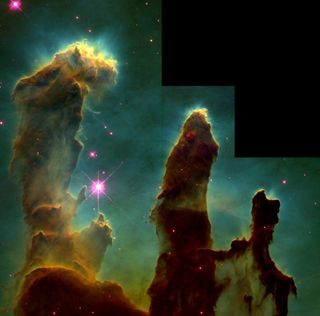Interstellar Gas Molecule Mystery Revealed

Scientists have untangled the structure of an elusive space molecule that may help astronomers better understand the vast clouds of interstellar gas across our Milky Way galaxy.
Unable to directly detect the coldest clouds of the most plentiful molecule in the universe, astronomers must rely on its interactions to find it. The search should become easier with an improved understanding of the compound H2-CO, frequently used as a tracer chemical.
After obtaining a very accurate reading of the most plentiful variety of this compound, an international team of scientists was able to map its distribution across space.
Tracking what you cannot see
H2-CO is important because it could be the key to locating molecular hydrogen in space. After the big bang, this crucial molecule, along with small traces of helium, dominated. Stars and galaxies formed as clouds of the material collapsed in on themselves.
Even today, molecular hydrogen makes up nearly three-quarters of the mass of the universe. Yet despite being so plentiful, it is nearly invisible when in its coldest state. Scientists can only detect it through its interactions with other elements. [The Universe: Big Bang to Now in 10 Easy Steps ]
Enter the weakly interacting complex H2-CO, which astronomers can use to locate these hidden clouds of hydrogen.
Get the Space.com Newsletter
Breaking space news, the latest updates on rocket launches, skywatching events and more!
"Almost all information about the most abundant molecule in space, H2, is obtained indirectly from measurements of the spectra of CO," Piotr Jankowski of the Nicolaus Copernicus University in Poland told SPACE.com by email.
By targeting clouds where carbon monoxide and hydrogen interact, in combinations such as H2-CO, astronomers can learn more about the dominant molecule in the universe. Because the complex isn't a completely new molecule, but instead two pieces that fit together, unraveling the mystery of the tracer complex will allow astronomers to understand more about molecular hydrogen as well.
"This procedure has been performed successfully for the first time for a complex of this size and for so complicated a spectrum," Jankowski said.
Back to basics
When molecular hydrogen (H2) and carbon monoxide (CO) come together to form the weakly interacting complex H2-CO, both fragments maintain their separate identities, rather than creating a brand-new molecule. The complex comes in two varieties, based on how the spin of the two bound molecules' nuclei align. When the nuclear spins are aligned in the same direction, the molecule is in its "ortho" state; when these spins are anti-aligned, it is in its "para" version. Although molecules in the ortho state are more abundant, they have also been more challenging for scientists to understand.
The difficulty comes from the combination of the compound's rotational motion with the vibrations between its components. In most molecules, the vibrational effects are more energetic than their rotational motion. However, this is not the case for the H2-CO complex, which renders the light spectrum coming from it much more complicated.
"There is no simple division of vibrations and rotations," Jankowski said.
Instead, the larger size of the vibrations tends to mask the signals of the rotational motion.
Jankowski, who was part of an international team that cracked the challenging code, explained that instead of simply observing the complex, the group used advanced theoretical methods to derive the theoretical spectrum, which almost perfectly matched up with what they saw in the experiment.
But the molecule was so complex that the team found themselves going back to the basics of quantum physics.
"We had to abandon the spectroscopic models and calculate the theoretical spectrum from first principles," Jankowski said.
The research appeared in the online version of the journal Science May 31.
Follow SPACE.com for the latest in space science and exploration news on Twitter @Spacedotcom. We're also on Facebook & Google+.
Join our Space Forums to keep talking space on the latest missions, night sky and more! And if you have a news tip, correction or comment, let us know at: community@space.com.

Nola Taylor Tillman is a contributing writer for Space.com. She loves all things space and astronomy-related, and enjoys the opportunity to learn more. She has a Bachelor’s degree in English and Astrophysics from Agnes Scott college and served as an intern at Sky & Telescope magazine. In her free time, she homeschools her four children. Follow her on Twitter at @NolaTRedd
Most Popular


